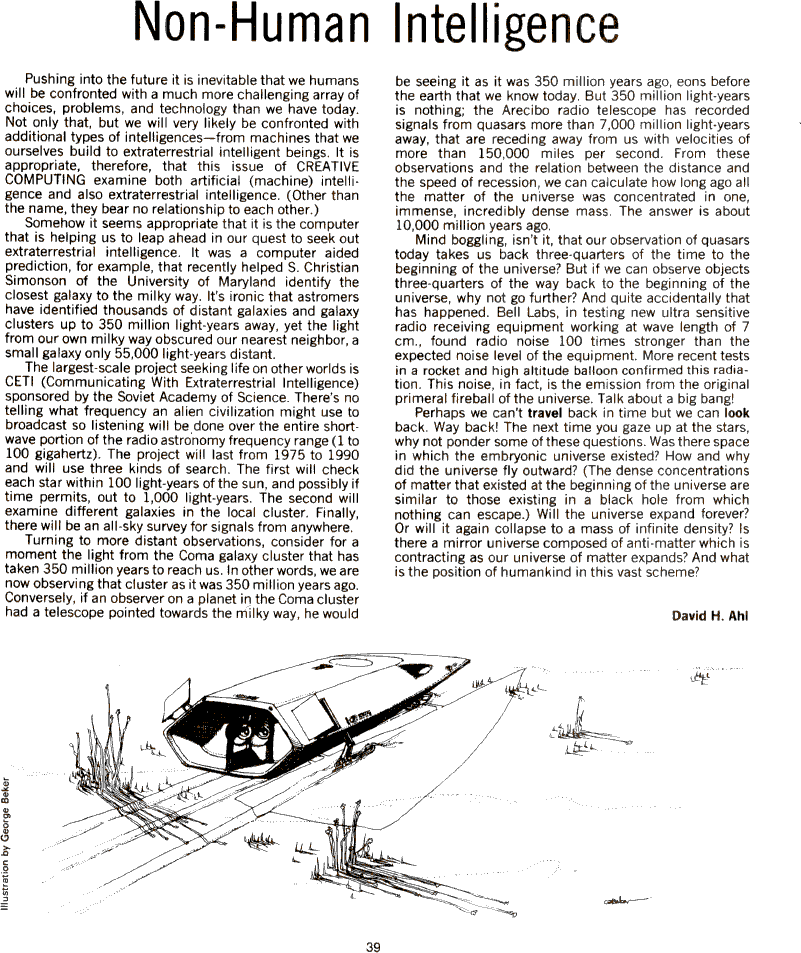by David H. Ahl

Non-Human Intelligence by David H. Ahl Pushing into the future it is inevitable that we humans will be confronted with a much more challenging array of choices, problems, and technology than we have today. Not only that, but we will very likely be confronted with additional types of intelligences-from machines that we ourselves build to extraterrestrial intelligent beings. It is appropriate, therefore, that this issue of CREATIVE COMPUTING examine both artificial (machine) intelligence and also extraterrestrial intelligence. (Other than the name, they bear no relationship to each other.) Somehow it seems appropriate that it is the computer that is helping us to leap ahead in our quest to seek out extraterrestrial intelligence. lt was a computer aided prediction, for example, that recently helped S.Christian Simonson of the University of Maryland identify the closest galaxy to the milky way. lt's ironic that astromers have identified thousands of distant galaxies and galaxy clusters up to 350 million light-years away, yet the light from our own milky way obscured our nearest neighbor, a small galaxy only 55,000 light-years distant. The largest-scale project seeking life on other worlds is CETI (Communicating With Extraterrestrial Intelligence) sponsored by the Soviet Academy of Science. There's no telling what frequency an alien civilization might use to broadcast so listening will be done over the entire shortwave portion of the radio astronomy frequency range (1 to 100 gigahertz). The project will last from 1975 to 1990 and will use three kinds of search. The first will check each star within 100 light-years of the sun, and possibly if time permits, out to 1,000 light-years. The second will examine different galaxies in the local cluster. Finally, there will be an all-sky survey for signals from anywhere. Turning to more distant observations, consider for a moment the light from the Coma galaxy cluster that has taken 350 million years to reach us. In other words, we are now observing that cluster as it was 350 million years ago. Conversely, if an observer on a planet in the Coma cluster had a telescope pointed towards the milky way, he would be seeing it as it was 350 million years ago, eons before the earth that we know today. But 350 million light-years is nothing; the Arecibo radio telescope has recorded signals from quasars more than 7,000 million light-years away, that are receding away from us with velocities of more than 150,000 miles per second. From these observations and the relation between the distance and the speed of recession, we can calculate how long ago all the matter of the universe was concentrated in one, immense, incredibly dense mass. The answer is about 10,000 million years ago. Mind boggling, isn't it, that our observation of quasars today takes us back three-quarters of the time to the beginning of the universe? But if we can observe objects three-quarters of the way back to the beginning of the universe, why not go further? And quite accidentally that has happened. Bell Labs, in testing new ultra sensitive radio receiving equipment working at wave length of 7 cm., found radio noise 100 times stronger than the expected noise level of the equipment. More recent tests in a rocket and high altitude balloon confirmed this radiation. This noise, in fact, is the emission from the original primeral fireball of the universe. Talk about a big bang! Perhaps we can't travel back in time but we can look back. Way back! The next time you gaze up at the stars, why not ponder some of these questions. Was there space in which the embryonic universe existed? How and why did the universe fly outward? (The dense concentrations of matter that existed at the beginning of the universe are similar to those existing in a black hole from which nothing can escape.) Will the universe expand forever? Or will it again collapse to a mass of infinite density? ls there a mirror universe composed of anti-matter which is contracting as our universe of matter expands? And what is the position of humankind in this vast scheme? [image]

